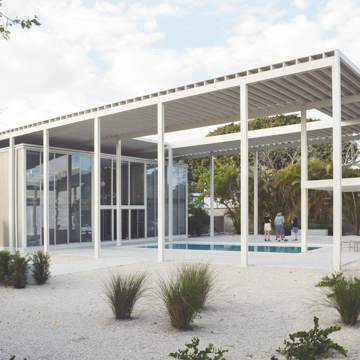Built as a speculative property for Philip Hiss, the architect, anthropologist, educator, and the remarkable and visionary developer of Lido Shores in Sarasota, the Umbrella House incorporates many of the ideas about skin, materiality, and structure found in Paul Rudolph’s earlier works, including the Cocoon House of 1950. The Umbrella House is a two-story, wood-and-glass box, created on a 32-inch standard, based upon the dimensions of the off-the-shelf jalousie windows, which are slipped beneath a roof-like, 3,000-square-foot, slatted wood canopy that extends over the house, patio, and pool. From the street facade, the only hint of the complexities within can be found in the sliver of space between the roof and the house (the bottom of the “umbrella”), which, with the cutout that references the pool below, forms a composition of pieces—solid, void, and frame—that are starting points for much of Rudolph’s later works.
Inside, shifted planes define the complex interior. The house rises up from the pool level; the floor of the conversation pit, with its working white-brick fireplace, shifts below; the walls of the second-floor bedrooms shift inward toward the center of the house, hanging over the double-height living area; and the walkway between the two bedrooms is lowered to a height just below that of the bedroom overhang. The complexity of what are essentially nine floor layers are both intriguing and, in some sense, disconcerting. The subtle spatial variations in Rudolph’s design creates a remarkable dialogue with Hiss’s contemporary studio next door. Designed by Tim Siebert, who was working in Rudolph’s office when the two projects were being constructed, the building is raised off the ground, creating habitable space below. Rudolph’s design creates an infinite assortment of views, light angles, and spatial possibilities, enhancing the spirit of the place without necessarily addressing utility. This avenue of investigation would culminate ten years later in Rudolph’s building for the Yale School of Architecture.
Used to shade the house from the intense Florida sun, the “umbrella” was destroyed by Hurricane Alma in 1966. The house and its canopy were restored by its owners in 2015 using original plans and drawings; however, the canopy design was updated to withstand hurricane winds. Now used primarily for private events, the house is maintained by the Sarasota Architectural Foundation.
References
Hill, Albert. “Saving Sarasota.” Wallpaper 72 (October 2004): 118–122, 124.
Howey, John. The Sarasota School of Architecture: 1941-1966. Cambridge: MIT Press, 1995.
McCarter, Robert. “Reviewed Work(s): The Sarasota School of Architecture, 1941–1966 by John Howey.” Journal of the Society of Architectural Historians 55, no. 2 (June 1996): 192–194.
Moline, Julie. “A Place In The Sun: Paul Rudolph’s Umbrella House No Longer Lives Up to Its Name, But Newly Restored, It Remains an Icon of the Sarasota School.” Interiors 159, no. 7 (July 2000): 36–41.








